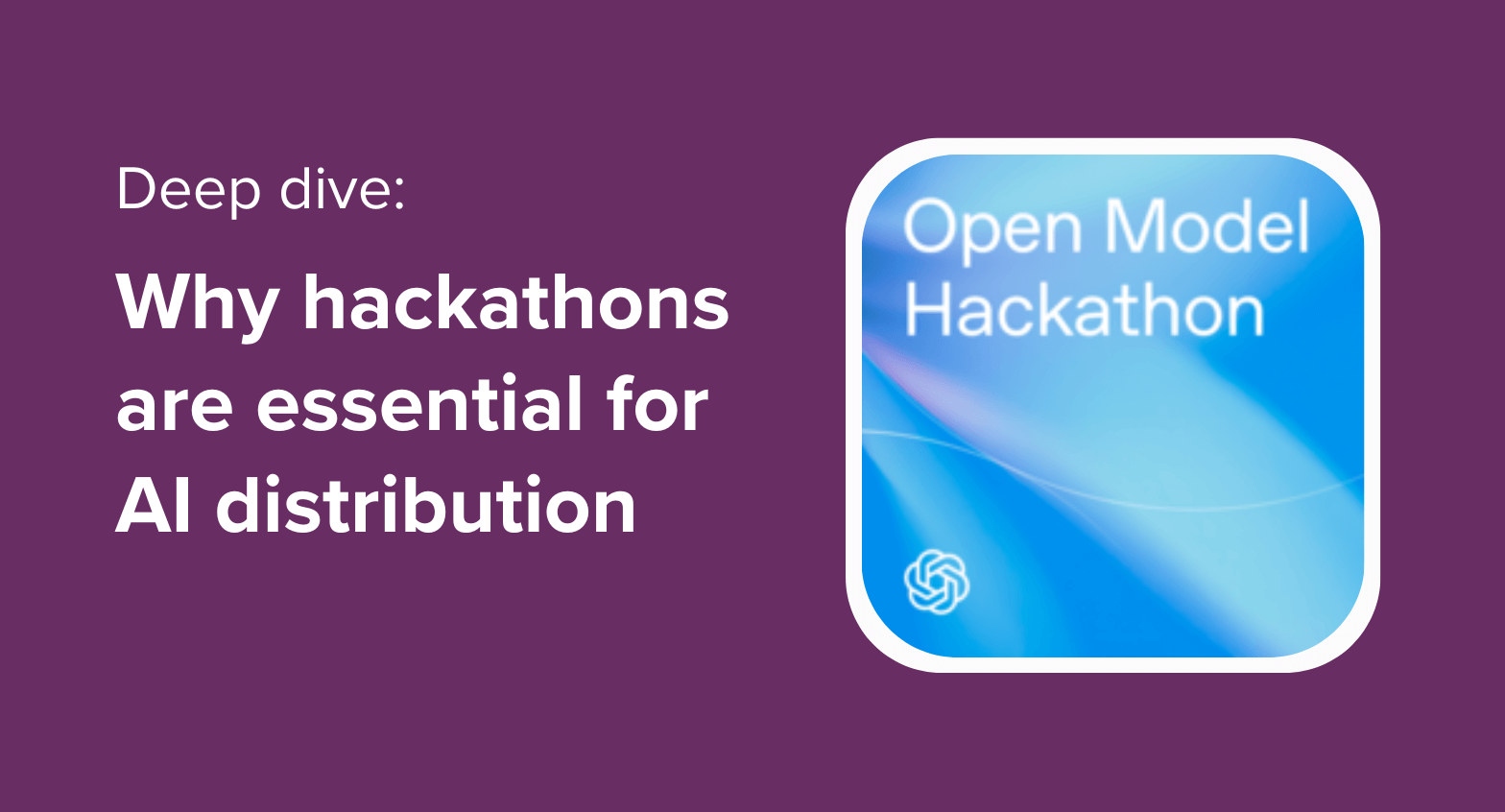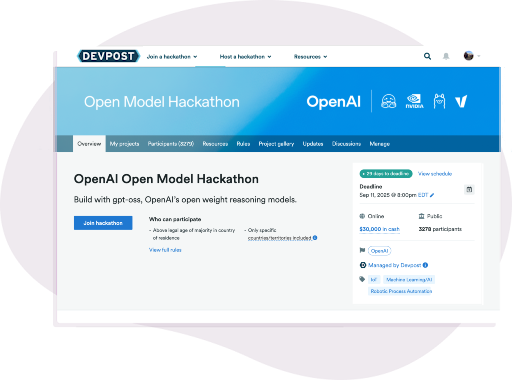What OpenAI’s Open Model Hackathon teaches about distributing AI
Explore how hackathons transform AI model launches into real-world projects.

Getting a breakthrough AI model into the hands of developers isn’t just about making it available—it’s about inspiring people to build with it. The teams that get developers building with their tools early often gain significant market share, set the first examples of how the tech is used, and build the ecosystems that others have to play catch-up with.
One of the most effective ways to make this happen? Hackathons. They give developers the space to try new technology, push it in unexpected directions, and build applications in just a few weeks.
Here’s a real-world example tied to OpenAI’s latest model release and related Open Model Hackathon.
A quick look at the gpt-oss models
OpenAI’s new gpt-oss 120B and gpt-oss 20B models are built with strong reasoning and to work smoothly with other tools. The models have been optimized to run locally on desktops, meaning they don't need an internet connection.
Because they don’t rely on a constant cloud connection, developers can experiment with new kinds of hardware-based AI projects. Developers can embed them into everything from offline robotics to quirky one-off gadgets—and the Open Model Hackathon is giving builders the chance to explore these possibilities.
How product teams can influence AI adoption
The rise of local, open-source AI models is shifting how new technology gains traction. Developers can immediately run, customize, and build with them.
And because they work offline, they can power AI experiences anywhere, even without reliable internet—making them perfect for hardware installations and creative edge-device use cases.
For product teams and innovation leaders, the takeaway is clear: these technologies are already here, and the organizations that stand out to developers will be the ones that shape early adoption. Which is exactly where hackathons come in.
Why hackathons are essential for AI distribution
Hackathons turn access into adoption. They give developers a chance to dive into new technology, a relatively short timeline to focus their creativity, and the freedom to explore applications that matter to them.
For companies launching AI models, that matters because the real question isn’t “Will people notice?”—it’s “Will people use it?” Hackathons make that leap happen faster and more effectively than passive documentation or static announcements.
In fact, in our experience, 5% to 33% of hackathon registrants submit completed builds—meaning these models are actually put to work. In comparison, traditional dev marketing tactics typically have a 1% conversion rate.
Hackathons are a powerful tool to distribute AI:
- They generate early use cases that prove the value of a model.
- They produce structured feedback and performance insights that companies can use to improve their tools.
- They encourage hands-on experimentation and iteration, which are essential when using AI.
- They create a surge of projects, content, and demos that can be used in future marketing materials to help reach a bigger audience.
{{callout-1}}
Hackathon benefits for organizers
For tech leads and innovation managers, hackathons can:
- Deliver rapid, diverse prototypes
- Surface high-potential use cases early
- Boost adoption and visibility with your target audience
- Attract new users and grow your developer community
Hackathon benefits for developers and builders
For participants, hackathons offer:
- Hands-on time with cutting-edge tools
- A chance to build portfolio-ready projects and gain recognition
- Learning opportunities with access to mentors, resources, and a supportive community
With both sides benefiting, hackathons are an ideal tool for distributing AI. Which brings us to an example in motion: the OpenAI Open Model Hackathon, where developers are applying the new gpt-oss models in creative and unexpected ways.
About the OpenAI Open Model Hackathon
The OpenAI Open Model Hackathon challenges participants to build projects that apply OpenAI’s new gpt-oss models in unique and unexpected ways.
The hackathon is co-sponsored by Hugging Face, NVIDIA, Ollama, and vLLM, who are providing resources to support participants’ projects and serving as judges for the submissions.
Key details
- Submission deadline: September 11, 2025 at 8 p.m. ET
- Total prize amount: $30,000 + NVIDIA GPUs
- What to build: Build a project by applying gpt-oss in creative, unexpected ways
- What to submit: Text description, demo video, URL to public code repository
Diverse challenges for participants to explore
Participants are tasked with building projects that apply the gpt-oss models in the most interesting way within one of the following categories:
- Best Overall: The absolutely most interesting application of gpt-oss.
- Best In Robotics: The most effective use of gpt-oss models in an IRL robot.
- Weirdest Hardware: The most creative and interesting hardware product that uses gpt-oss models.
- Best Local Agent: The most useful agentic application of gpt-oss with no internet access.
- Most Useful Fine-Tune: The most effective use of gpt-oss for specialized domains, through fine-tuning.
- Wildcard: The most unexpected use of gpt-oss that OpenAI didn’t think of.
- For Humanity: The best application of gpt-oss that benefits all of humanity.
Working with Devpost for AI hackathons
At Devpost, we’ve seen how the right challenge can unlock developer creativity—and how the right platform can multiply results. Our community of 4+ million developers is ready to build projects that put your technology in the spotlight.
Beyond just providing a robust hackathon management platform, Devpost offers comprehensive services designed to maximize your event's success:
- End-to-end hackathon management and platform support
- Strategic developer marketing and community outreach
- Custom challenge design and implementation
- Participant engagement and coordinating technical support
- Ensuring legal compliance and prize fulfillment

The bottom line
New AI models can only change the world if people put them to work. Hackathons are one of the fastest ways to bridge that gap—turning a model launch into a wave of new users, creative projects, and early proof points. Whether you’re distributing your own AI tool or competing to capture developer attention, getting hands-on adoption early can make the difference between leading an ecosystem and chasing one.
Planning your own developer event? We've worked with AI companies to design hackathons that actually move the needle—from structuring challenges that showcase your technology to building communities that stick around afterward. Let's discuss your hackathon strategy.





